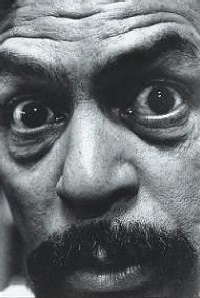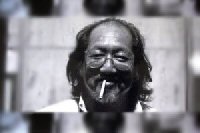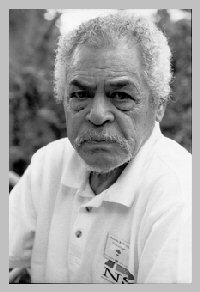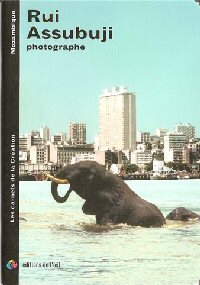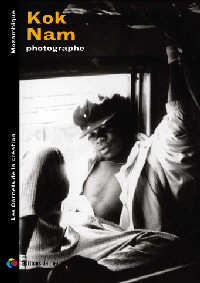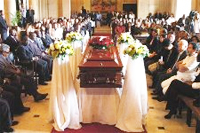Mozambican Photography and Photographers
1960s to 1990s
Dossier MZ-0057
![]()
To be clear: this web page is not intended to offer an archive of photographic images. For that, you must go elsewhere. As a dossier, this page rather presents some links to websites where information about some important Mozambican photographers may be found, some bibliographic data, and a few press clippings and articles about the uses that Mozambican photographic images – some of them iconic in status – have been put to over the years.

Left, from the top: Ricardo Rangel, Self-portrait, 1972. Kok Nam. Ricardo Rangel in old age. Cover of book of photographs by Rui Assubuji, available here. Cover of a book of photographs by Kok Nam, available here. Above: the cover of one of the best general books on Mozambican photography: Bruno Z’Graggen and Grant Lee Neuenburg, Iluminando vidas: Ricardo Rangel and the Mozambican photography (Basel: Christoph Merian Verlag, 2002). The cover, a detail from a photograph of one of the women of the Rua Araújo is from the famous series by the late Ricardo Rangel (1924-2009).
Taking photographs, like writing poetry and playing football, is one of the staple activities of the Mozambican intellectual class. As Bruno Z’Graggen has written:
Mozambican photography is photo reporting with commitment. It depicts people with respect and focuses on them with dignity. Characterised by empathy and precision, it tells of many-facetted worlds and denounces injustice. It encompasses the period of the ‘tempo colonial’, the 50’s, the war of independence and the separation from Portugal in 1975, the civil war, the peace agreement of 1992 and the departure into a new and more promising future. Its approach renders it immune against being highjacked by powerful interest groups. It has become a moral authority and helps create an identity in post-colonial Mozambique [Iluminando vidas, page 7].
The photographers whose pictures appear in Iluminando vidas are Ricardo Rangel himself, Kok Nam, Joel Chiziane, João Costa (Funcho), Rui Assubuji, Alfredo Paco, Luís Basto, Naíta Ussene, Alfredo Mueche, Martinho Fernando, Ferhat Vali Momade, Albino Mahumana, José Cabral, Alexandre Fenias and Sérgio Santimano.
The doyen of Mozambican photographers was the hugely influential Ricardo Rangel (1924-2009). He started working as a darkroom assistant in private studios during the 1940s, but in 1952 became the first black photographer to work for a Mozambican newspaper when he was hired by Notícias da Tarde. He later worked for A Tribuna and was involved in the founding of the local weekly Tempo in 1970. In 1981 he became the editor-in-chief of a new Sunday paper, Domingo, and was involved in training young photographers and in setting up the national Associação Fotográfica Moçambicana. He died at the age of 85 in June 2009.
Ricardo Rangel was a sharp critic of lazy photojournalism, and in 2002 published a short book entitled Foto-jornalismo ou foto-confusionismo in which he pilloried carefully selected examples of bad pictures and/or bad captions from the local press. In the example below, which was captioned ‘In Nampula, liberation war veterans want their pensions paid out more quickly’ by the editor, Rangel asks the reader ‘But what do the veterans see in space? What are they pointing at? Maybe WHO is dropping food from aeroplanes’.
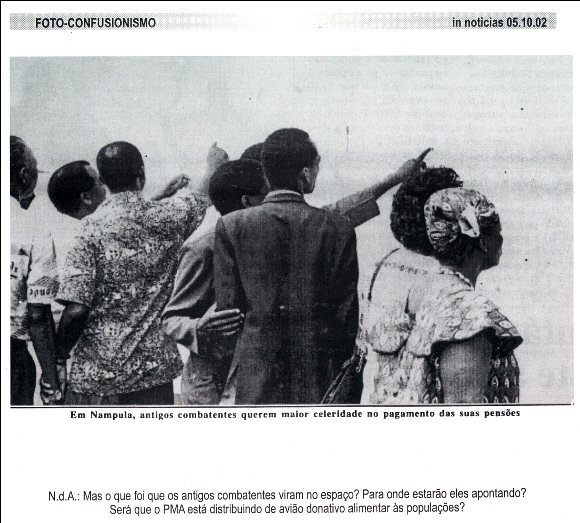
Rangel’s best known work is a series of evocative studies of bar-girls in the colonial-era red-light district of the then Lourenço Marques, the Rua de Araújo. The series was entitled «Pão Nosso de Cada Noite» (an inversion of the phrase from the Pater Noster or Lord’s Prayer – «Give us this day our daily bread»), and some of the pictures are available online at the Afronova website, here. A short 2005 interview by Teresa Lima is transcribed on the BBC website, here, and Carlos Serra’s tribute is online here, with a picture of musicians playing jazz at the cemetery during Rangel’s funeral ceremony. The complete «Pão Nosso de Cada Noite» was published in a quality edition by Marimbique in Maputo in 2004 (cover shown below).
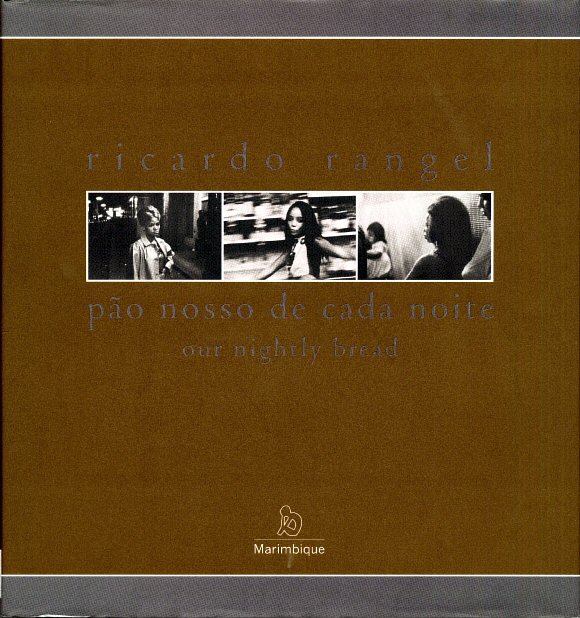
Other influential figures include Kok Nam and Naíta Ussene (1957- ). Ussene began working at Tempo in 1974 as a «servente», and in 1976 was picked to became a photographic apprentice under Kok Nam. He parted company with Tempo in 1996, after participating as a member of the group of 13 journalists, including Kok Nam, who founded Mediacoop. He later worked for the independent weekly Savana, of which Kok Nam was editor, and was a member of the Mediacoop board.
Kok Nam (1939-2012) was the Mozambican-born son of immigrants from Canton. In 1966 he started working as a photographic journalist in Lourenço Marques for the Beira paper Diário de Moçambique, and two years later switched to Notícias where he worked with Rangel. In 1970 he was involved in the establishment of Tempo where he eventually became chief photographer. His photographs have been widely published in the international press. Kok Nam died in August 2012, and at his funeral the Minister of Culture, the writer Armando Artur, offered this tribute:
… não é assim tão fácil esboçar em poucas palavras o perfil de uma figura de reconhecido mérito, como a de Kok Nam. Sabemos que, avesso a protocolos, o embondeiro do nosso fotojornalismo sentia-se melhor calcorreando o chão da pátria, sempre com a máquina a tiracolo, observando e registando imagens do seu País, naquela simplicidade que o caracterizava. Curvamo-nos perante um homem que, através da sua lente fotográfica, consolidou o seu estatuto de trabalhador incansável, fixando com a sua câmara fotográfica, momentos ímpares do quotidiano dos moçambicanos … [Source: Notícias, Maputo, 18 August 2012].
![]()
Links to other Sites
◊ Fotografia Moçambicana, 1950-2001
This site is in essence the digital manifestation of the book Iluminando Vidas referred to above. It is also an «itinerant exhibition on contemporary Mozambican photography. It is the first exhibition to offer a comprehensive view of Mozambican photography». An well-organised website with samples of the work of most of the major figures. Click here to jump to the site.
◊ O Mundo Através dos Meus Olhos.
This website, sub-titled «Fotografias por Jovens Moçambicanos», is available in both Portuguese and English. Although the site says that Mozambican photography is «underdeveloped», its commendable objective is to bring ‘brighter tomorrows’ to young Mozambicans through photography. The project ‘helps Mozambican children learn about and experiment with photography’, arguing that ‘Mozambique’s culture and many of its traditions … [are] being lost … Photography can be used to preserve culture and traditions by recording the present for future generations’. Click here to jump to the site.
◊ Alexandre Pomar. Fotografias de Moçambique: Bibliografia.
This is one page, dated 16 August 2007, on a larger blog site devoted to the fine arts in general. Pomar provides, with some illustrations (mainly book covers), a useful list of published works that either deal with photography in Mozambique directly, or use photographs effectively in pursuit of some other end, e.g. Ruth First’s book Black Gold, on migrant labour, with photographs by Moira Forjaz. Click here to jump to the Pomar site.
![]()
Frelimo’s Iconography
There are several iconic images in Frelimo history that function politically as well as aesthetically to deliver a specific message, whether consciously or not. Some examples:
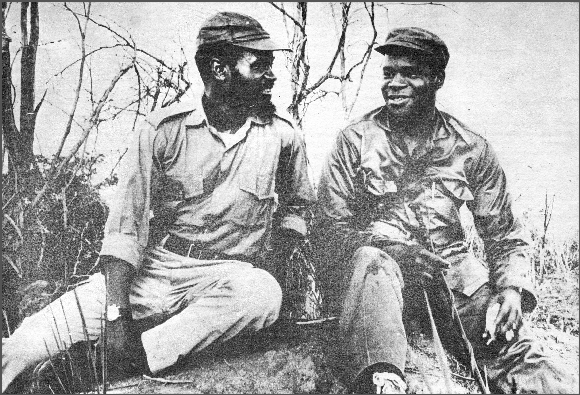
Above: this photograph shows Samora Machel and Eduardo Mondlane relaxing together, somewhere in northern Mozambique during the armed struggle. Mondlane was assassinated in 1969, and various opposition groups such as FUMO or Renamo subsequently claimed that they were the his true heirs, that they represented his thought, and that Frelimo’s Marxism was a distortion created by Samora’s leadership. What the photograph does iconically is to establish the (physically) close comradeship between the two men, and the mentorship of Mondlane, who is gazing into the distance while Samora, the student, looks directly at him. Samora is thus seen to have had a direct connection with Mondlane.
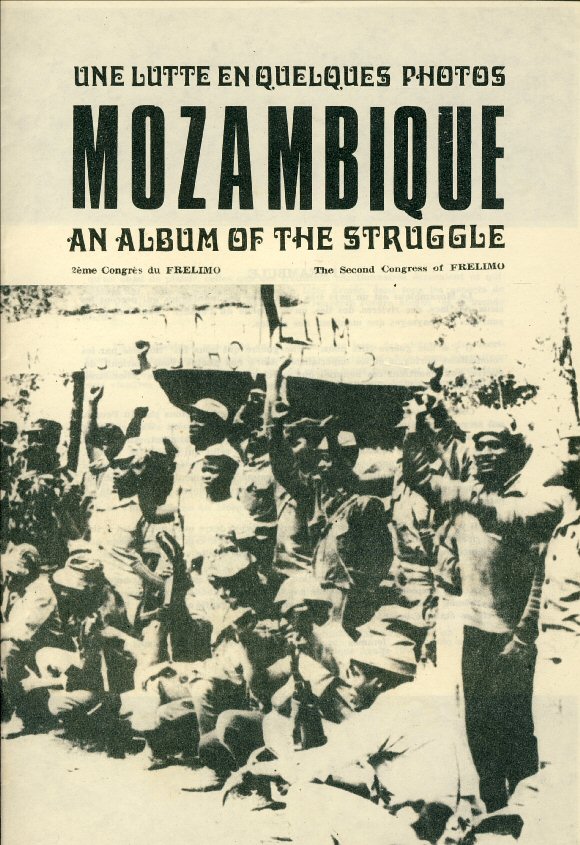
Above: the cover of a Frelimo pamphlet, consisting almost entirely of photographs and published in Cairo in 1970 by the Afro-Asian Peoples’ Solidarity Organization (AAPSO). Frelimo realised the power of the image, both photograph and film, early on in the struggle.
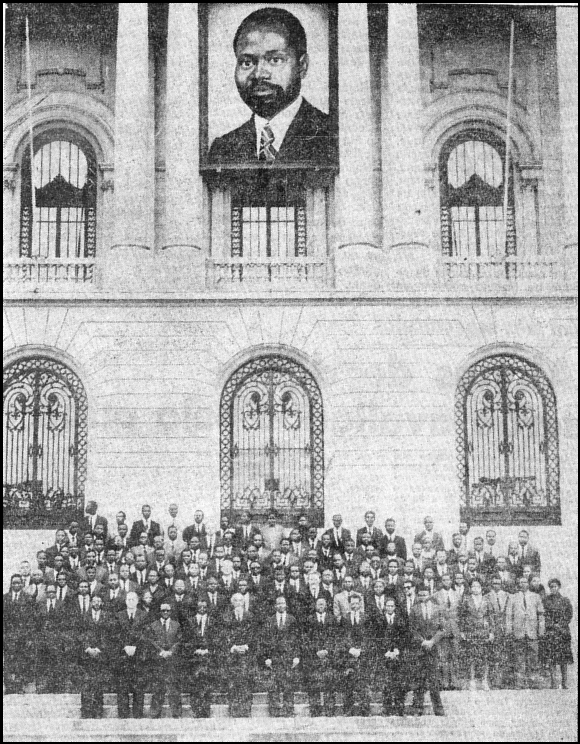
Above: this 1986 photograph is not particularly well-known, but is interesting. It shows the Frelimo Central Committee gathered on the steps of the Conselho Executivo [city hall] of Maputo in early November 1986, having just ceremonially deposited flowers on the grave of Samora Machel, killed a few weeks earlier on 19 October at Mbuzini. Again, the picture models order and continuity to legitimise Joaquim Chissano as Machel’s successor. The Central Committee is standing in neat rows under an enormous portrait of Machel, and the formal architecture of the building lends gravitas to the occasion.
![]()
MHN Resources
◊ 11 June 1978
Exposição fotográfica na ONJ. Tempo [Maputo], no.401, 11 June 1978, p.16. Jorge Rebelo, the Minister of Information, opens a photographic exhibition at the Organização Nacional de Jornalistas. Photographers exhibiting included Amadeu Merrangula, Carlos Calado, Fernando Silva, João Costa, José Cabral, José Machado, Kok Nam, Luís Bernardo Honwana, Luís Souto, Moira Forjaz, Naíta Ussene, Reginaldo Faria Leite, Ricardo Rangel and Rogério. Prints of the photographs were for sale at 300$00 each. Click here to view or download a PDF, size 199 kb.
◊ 27 December 1980
Willy Waddington. A propósito de fotografia: a nossa história pela imagem. Notícias [Maputo], 27 December 1980. Click here to view or download a PDF, size 466 kb.
◊ 15 February 1981
Na vida e no trabalho de dois fotógrafos: entrevista com Daniel Maquinasse e Ricardo Rangel. Tempo [Maputo], no.540, 15 February 1981, p.22-25. Click here to view or download a PDF, size 695 kb.
◊ 8 July 1984
Torres Rodrigues. Daniel Maquinasse, guerrilheiro-fotográfo: «Numa emboscada não pensava na máquina fotográfica». Domingo [Maputo], 8 July 1984, p.16. An interview. Click here to view or download a PDF, size 378 kb.
◊ 5 November 1986
Foto histórica. Notícias [Maputo], 5 November 1986. For commentary, see above under the heading Frelimo’s Iconography. Click here to view or download a PDF, size 480 kb.
◊ 3 February 1987
Uma foto inédita. Notícias [Maputo], 3 February 1987. A previously unpublished photograph of Eduardo and Janet Mondlane during their visit to Mozambique in the early 1960s, before the foundation of Frelimo. Click here to view or download a PDF, size 256 kb.
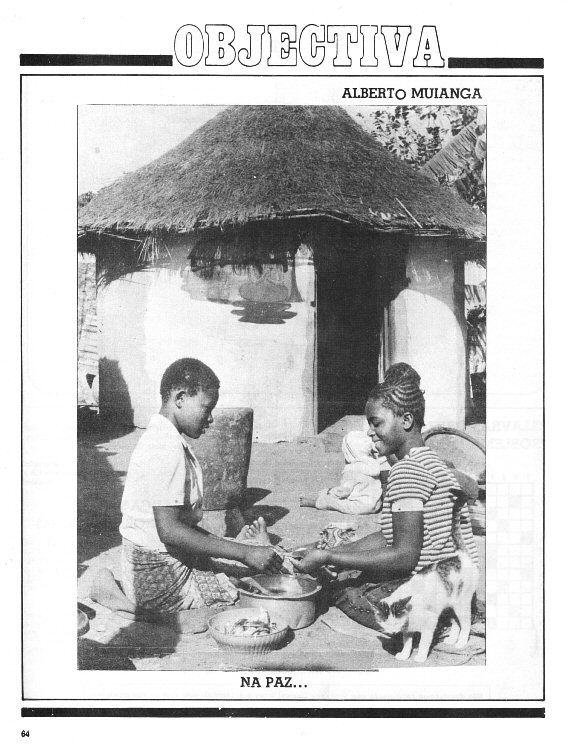
Above: the weekly illustrated news-magazine Tempo routinely carried a feature entitled «Objectiva» on its last page, just inside the back cover. This was a single photograph, with a title and the photographer’s name, but no commentary or explanatory text. The example above is by Alberto Muianga and was published in the issue of 14 August 1988. Below: a tribute to Ricardo Rangel published on the front page of Notícias to mark his 70th birthday on 13 February 1994.
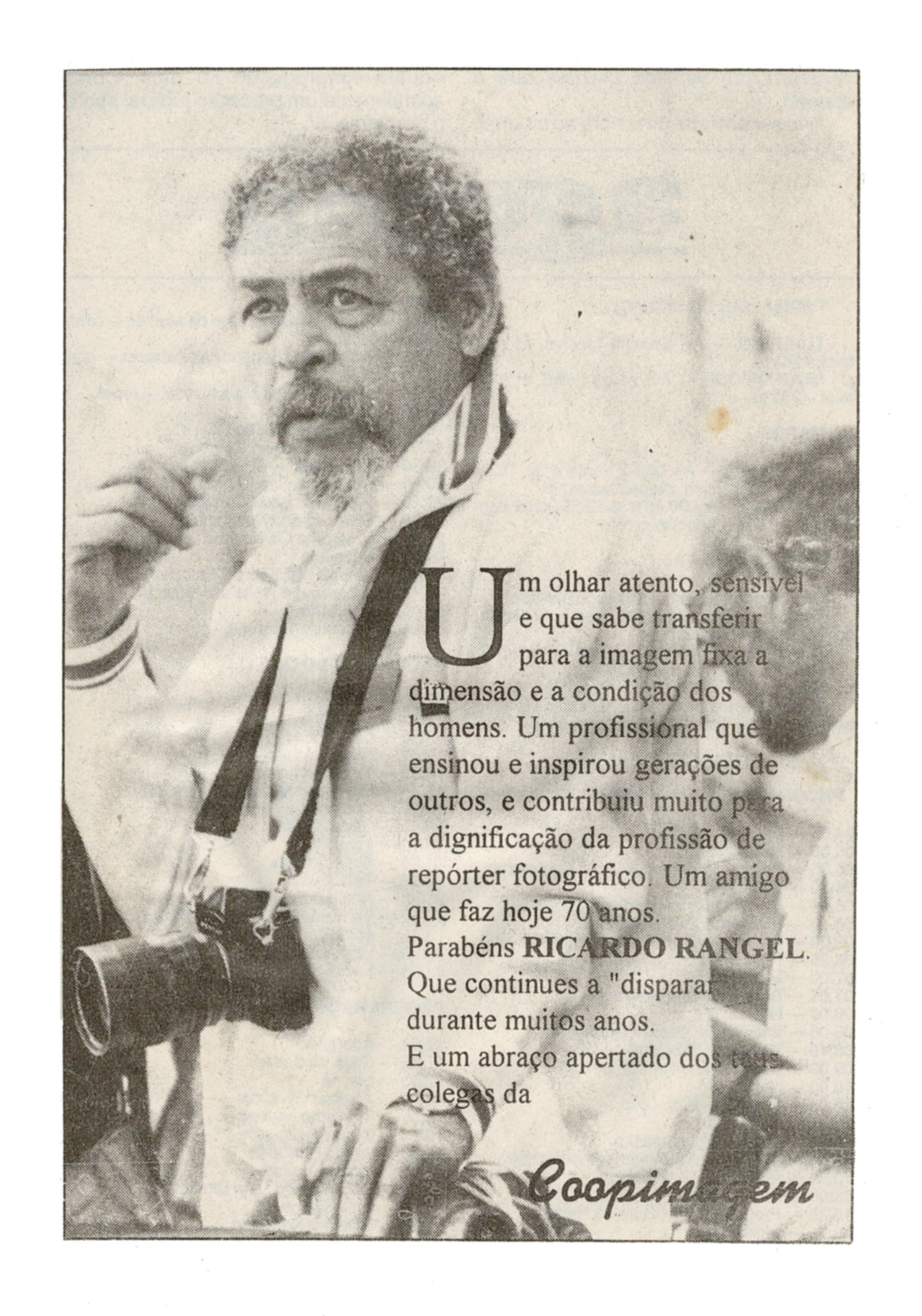
![]()



![Aluka: Struggles for Freedom [subscription required] Struggles for Freedom](imgs/aluka_200.png)



